
Pets | Resources
Living Trees
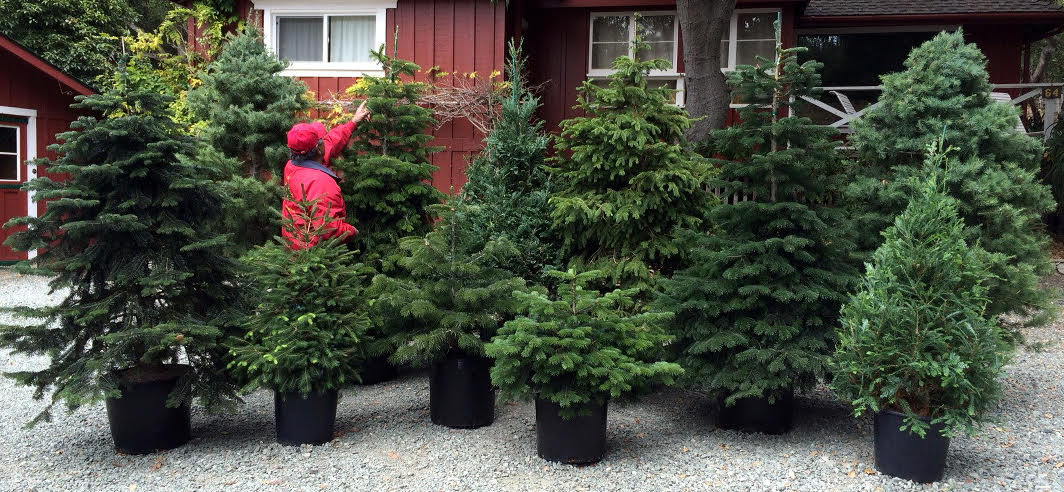
Instead of cutting a tree for the holidays, you can plant one, when you choose a living tree. Sold in containers, living trees have their roots intact and can be planted outdoors or grown in their containers following the holiday.
PLANTING YOUR TREE OUTDOORS
The most important decision to make when choosing a living tree is where it will be planted after the holiday season.
Choose the spot to plant your tree before you buy, making sure that there is plenty of room for the tree to grow.
If you don’t have space on your property to plant a tree, find out about tree-planting programs in your community who would welcome a post-holiday donation. If you decide to make a gift of your tree, be sure to check with the recipient regarding preferred species.
If you have a large yard that needs planting, you can plant a “holiday tree grove”. Each year purchase a tree and add it to the grove. This will become a special place to enjoy year-round, and a reminder of past celebrations.
Once planted, outdoor evergreens can be decorated and serve as a holiday tree for the neighborhood.
CONTAINER TREES
If you have limited space, you can plant a living tree in a container and bring it indoors each season. The remainder of the year it can add background greenery to a deck or patio.
You can keep your tree a manageable size with yearly pruning. Our recycled Worldwise EcoPlanter is especially suited for this purpose as it will not break, chip, or crack in cold weather and will last as long as the tree.
Nurturing a tree throughout the year gives it a special meaning during the holidays. Because you participate in its growth and care throughout the whole year, it becomes part of your family, a “friend” who comes to celebrate with you year after year. You could start with a tree seedling and watch it grow, particularly if you start it on a child’s first holiday or a first holiday of a marriage.
CHOOSING THE RIGHT SPECIES
The most important aspects of choosing the right species are to choose a species that will thrive in your area, and how fast the tree will grow. If you are planting outdoors, you probably want a tree that will quickly grow to full size. If you are going to keep it in a container, it is best to choose a species that is naturally slow-growing.
These are the most popular species for living holiday trees:
| Common name | Scientific name | Nursery sizes | Best climates |
| Slow growth | |||
| WHITE FIR | A. concolor | 1-6 feet | Everywhere |
| COLORADO BLUE SPRUCE | P. pungens ‘Glauca’ | 1-6 feet | Everywhere |
| NORWAY SPRUCE | Picea abies | 3-7 feet | Everywhere except south and deserts |
| DWARF ALBERTA SPRUCE | P. glauca ‘conica’ | 1-4 feet | Everywhere except deserts |
| NOBLE FIR | Abies procera | 3-6 feet | NE, W, Midwest, Rockies |
| Average growth | |||
| JAPANESE BLACK PINE | P. thubergiana | 1-6 feet | Everywhere |
| NORFOLK ISLAND PINE | Araucaria heterophylla | 1-7 feet |
Tropical, Subtropical, SW, S, Gulf Coast
|
| SCOTCH PINE | Pinus sylvestris | 2-8 feet | NW, W, Midwest, Rockies |
| DOUGLAS FIR | Pseudotsuga menziesii | 3-7 feet | NW, W, Midwest, Rockies |
| Fast growth | |||
| ALEPPO PINE | P. halepensis | 2-6 feet | S, SW, deserts |
| MONTEREY PINE | P. radiata | 2-8 feet | N, Midwest, E, W |
| MONDELL PINE | P. eldarica | 1-8 feet | SW |
CARING FOR YOUR TREE INDOORS
Since warm indoor air is not the native winter habitat for evergreen trees, it is important to properly care for your tree to keep it green and healthy through the holidays.
Limit indoor time to two weeks, and place it on the opposite side of the room from any heat sources, including fireplaces and woodstoves, heater vents, and unshaded south-facing windows.
Use “cool” 5-watt lights on the tree, as heat from regular lights can dry out the tree.
Give the tree a good soaking before bringing it indoors. Let it drain for a day or two to prevent ending up with a puddle on the floor. Make sure to put the pot in a saucer and the saucer on a Worldwise SurfaceSaver to protect the floor. Water every three days to keep the soil moist.
For time-release watering, and to keep the tree cool, try watering with ice cubes. As they melt, the tree roots will slowly absorb the water.
“Hypoallergenic” Trees
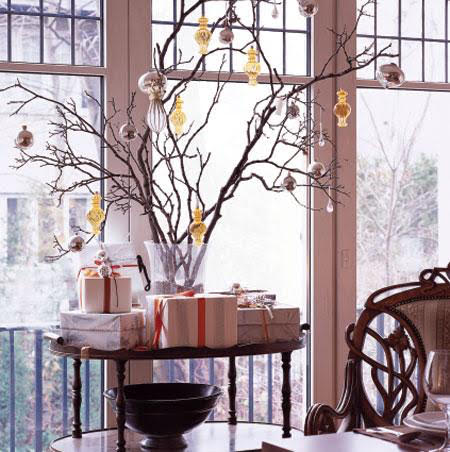 If you are sensitive to any evergreen tree, you could, obviously, use a fake tree made of plastic or metal, but there are ways to make a real tree more tolerable. People with sensitivities have given me some great ideas.
If you are sensitive to any evergreen tree, you could, obviously, use a fake tree made of plastic or metal, but there are ways to make a real tree more tolerable. People with sensitivities have given me some great ideas.
- Decorate a live tree outside and put it in a picture window. That way you can see it but don’t have to smell it. Then place your gifts “under” the tree by putting them under the window. You could even plant a live tree in the window so it would be there year after year.
- Put up a tree with outdoor lights and bird food (pine cones with peanut butter and millet branches) outside a picture window. Your tree will be filled with birds.
- Find any green plant that you tolerate and decorate it with lights and ornaments.
- Use bare branches from a florist or outdoors and decorate it with Christmas tree ornaments.
One year, when I was on a very tight budget, I decorated a branch that had fallen in a storm. Though evergreens have a tradition with being associated with the continuation of life through the long winter, really you can decorate anything—it’s the spirit that counts!
Nontoxic Christmas Tree Ornaments
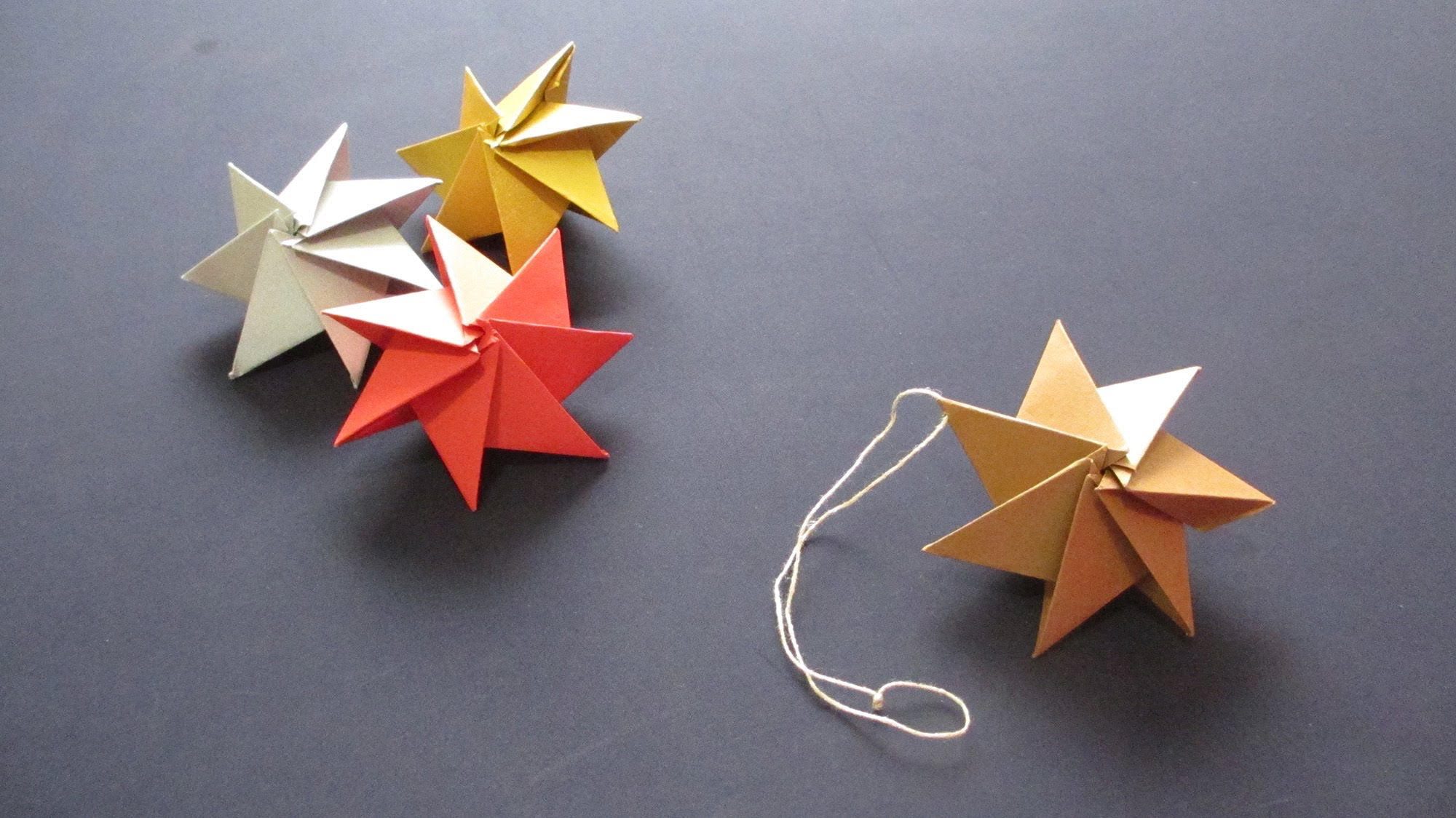 Instructions at https://youtu.be/GHMRnBRf6_c
Instructions at https://youtu.be/GHMRnBRf6_c
Like most everything else today, it seems like most Christmas tree ornaments are made from plastic and other synthetic materials. But that wasn’t always so.
The first ornaments on holiday trees reflected the “ornaments” hanging on natural trees during the season: fruits, nuts, and cones. To continue this tradition:
- Tie small red and green apples to the tree with colored ribbons
- string fresh cranberries and popcorn
- glue gold tie to nuts and hang them
- hang dried apple rings and cinnamon sticks for fragrance.
Cookies are a popular tree decoration. Gingerbread cookies add a wonderful fragrance to the natural scent of the tree. If you wish to make inedible “cookies” that you can reuse year to year, try this recipe:
Reusable “Cookie” Ornaments
1 cup salt
2 cups flour
1 cup water
2 tablespoons vegetable oilSpices or powdered pigments can be added to color the dough
Mix dry ingredients together in a bowl. Add water and oil and stir until blended. Knead with your hands to make a smooth texture. Roll dough out on a cutting board to desired thickness (thick enough so they won’t break easily) and cut with cookie cutters or a knife. Use a straw to make a hole at the top for threading a ribbon. Bake at 250 degrees until hard (1-2 hours).
When cookies are cool, decorate with water-based paints. Put a ribbon through the hole, and hang on the tree.
Eggshells can also be made into ornaments.
- Poke a hole into each end of an egg with a sterilized sewing needle.
- Over a bowl, blow into the hole the top of the egg (the small end) so that the insides come out through the bottom hole. Save the egg insides for cooking. Paint eggs with water-based paints.
- Bend a pipe cleaner and stick it in the top of hole of the egg. Bend the other end and hang it on the tree.
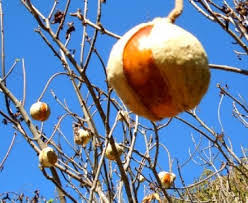
California buckeye
You can also decorate your tree with whatever is growing naturally in your area. Here in Northern California, buckeye trees lose their leaves during the fall, leaving branches hung with “buckeye balls” that are just the size of tree ornaments. We also have a native shrub called coyote bush that produces a small white flower in December that makes it look like it is covered with snow. Branches of coyote bush placed between tree branches makes holiday tree look like it just came in from a frosty forest, without the fake snow flocking.
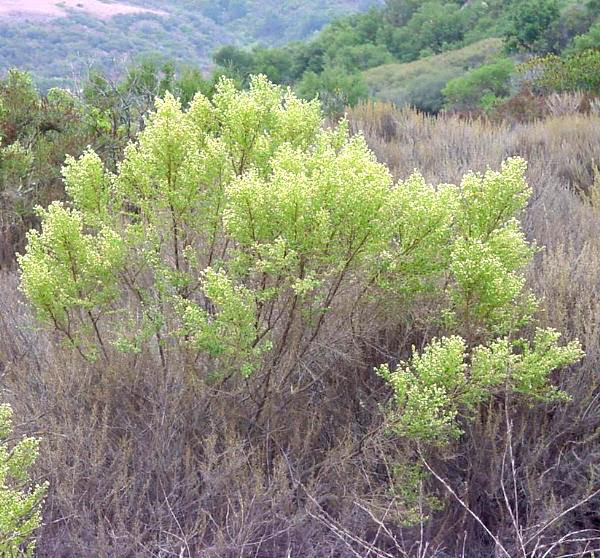
Coyote bush
Check your own garden and community for cones, berries, dried seed pods, twigs, and feathers. After the holidays, they can go in the compost.
Save holiday wrapping paper, greeting cards, and other interesting papers and pictures (including pages from magazines) throughout the year. Designate a box for collecting them instead of throwing them in the trash, then use them to make colorful and interesting paper ornaments:
- Origami and other paper craft books will have many good ideas and instructions.
- Make paper chains by making a loop with a strip of paper, then staple it shut and make another loop by sliding the strip of paper through the first loop.
- Cut paper ‘snowflakes’ from used office paper
- Images from old holiday cards or cut from magazines can be trimmed and tied to the tree with a ribbon (magazine images will need to be glued to a 3×5 card or scrap cardboard for stiffness).
Throughout the year, look for ornament possibilities at flea markets and garage sales. Keep your eyes open for ornaments for sale and any small items that would make interesting ornaments. Look for materials that could be modified in some way to make ornaments.
The History of Holiday Trees
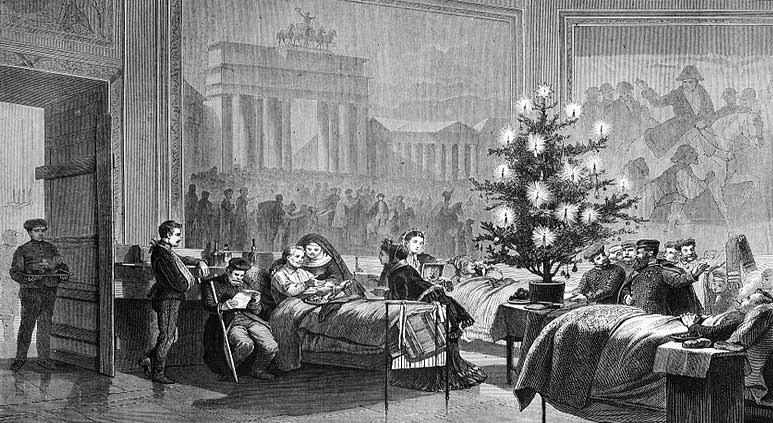
When we celebrate the winter season by decorating our homes with evergreen trees, wreaths, and boughs, we continue a tradition that has its roots in the earliest beginnings of humankind. Throughout the world, virtually every culture has used evergreens for some kind of celebration around the Winter Solstice – a yearly affirmation of the continuation of Life and renewal of our integral participation in all Life. By honoring the tree with decorations, we acknowledge Nature and its continuous cycles that sustain our lives.
After the last ice age, Europe was covered with immense forests. Because prehistoric people depended on the forests for food and shelter, fire, transportation, and tools, trees were an important part of their environment. In addition to their practical uses, trees seemed to embody the cycle of Nature itself—they grew and made sounds, gave birth to leaves and flowers and fruit, they “bled” when cut, and became old and died.
Trees symbolized fertility and life, strength, and steadfastness of spirit. Where evergreens were abundant, they became the trees more highly revered—while other trees lost their leaves and seemed to die during the winter, the evergreens stayed fresh and green, even through the most severe weather. That evergreens continued to hold their leaves and their “life” through the bleakness of winter resulted in their use as powerful symbols of the continuance of life. Evergreen boughs were reminders of the green plants that would grow again when the light-filled days of summer returned.
EVERGREENS IN ANCIENT CELEBRATIONS
Including trees in celebration and worship is common around the world. In China, sacred trees bore red banners with words of praise and thanksgiving on them. Greek and Roman goddesses and gods each had their special trees, which were draped in garlands of flowers.
The Winter Solstice marks the point of deepest darkness and, following, a return of the light that made Nature green and fruitful.
The use of evergreen trees for celebration at Winter Solstice began with the exchange of fir-tree twigs and the display of fir-tree twigs and branches on homes and in meeting places as a wish for the continuation of life. These twigs developed into bundles, then later into the whole tree.
Romans decorated their homes and temples with evergreen boughs. Winter Solstice was a special time of peace and equality when wars could not be declared, when slaves and masters could eat at the same table.
Eqyptians brought green date palm leaves into their homes to symbolize life’s triumph over death.
European Druids tied apples to the branches of oaks and firs to thank the god Odin for blessing them with fruitfulness, and also made offerings of cakes shaped like fish, birds, and other animals. Lighted candles, honoring the sun god Balder, were placed on the boughs. The Druids used evergreen holly and mistletoe as symbols of eternal life, and placed evergreen branches over doors to keep away evil spirits.
Late in the Middle Ages, Germans and Scandinavians placed evergreen trees inside their homes or just outside their doors to show their hope in the forthcoming spring.
THE FIRST CHRISTMAS TREE
Legend has it that the tradition of decorating trees to celebrate Christmas began with Reformation leader Martin Luther.
One clear, crisp Christmas Eve, around the year 1500, Luther was walking home through the woods. He paused for a moment in a grove of tall pine trees to gaze at the beauty of the starry sky. The fragrance of the pines reminded him of incense and the wind in their branches sounded like a congregation at prayer. From where he stood, it seemed like thousands of stars had settled on snow-dusted branches. Luther brought a small fir tree home and covered with small candles so he could share this story with his children. He lit the candles in honor of the birth of Christ.
The first Christmas tree actually documented occurred in 1605 in Strassburg, Germany. It was without candles, but decorated, as the Druids did, with bright red apples.
The Christmas tree migrated next to Austria and France, and then to England. When Queen Victoria of England married Prince Albert of Germany in 1840, he brought to England his German Christmas tree, which was by then covered with candles and hand blown glass ornaments. Pictures of the Queen and her family around a tabletop tree appeared in the newspapers, and soon all England had similar trees.
THE CHRISTMAS TREE IN AMERICA
The Christmas tree became the central focus of holiday celebrations in American homes a few years later when Gody’s Lady’s Book published a drawing of a family around a Victorian decorated tree. The Christmas tree may have come to the United States as early as the late-1700s, with German soldiers who were hired to bolster English troops during the American Revolution. According to legend, on the bitter cold Christmas Eve of 1776, at Trenton, New Jersey, the presence of a candlelit evergreen tree so reminded German soldiers of home that they abandoned their guard posts to eat, drink and be merry. George Washington attached that night and defeated them, turning the tide for the Revolution.
COMMERCIAL CHRISTMAS TREES
The commercial Christmas tree market began in 1851 when Catskill farmer Mark Carr hauled two ox sleds of evergreens into New York City and sold them all. By 1900, one in five American families had a Christmas tree, and 20 years later, the custom was nearly nationwide.
Christmas tree farms began during the depression. Nurserymen couldn’t sell their evergreens for landscaping, so they cut them for Christmas trees. Cultivated trees were preferred because they had a more symmetrical shape than wild ones.
Wreaths and Wreathmaking
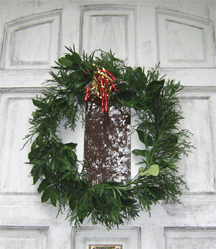
Wreath I made myself in Florida in 2005.
Wreaths are now a common sight at all times of year, but they have their origins in the ancient wreaths made for Winter Solstice.
Back in pre-industrial times, people were dependant for their survival on what they could obtain from their natural surroundings. In the northern latitudes, winter was a time when there was little food. This made the Winter Solstice very important, for on that day the days would begin to get longer and light and life would return to the Earth.
Because the return of the sun was so important, they deveoped traditions they believed would ensure the return of the light.
The everygreen wreath was one of these traditions. By making wreaths in circular shapes using evergreens that continued to survive when all other plants had died, they aligned their own intentions for life with the process occurring in nature.
Though evergreen wreaths are widely sold everywhere at Christmas time, I like to make my own. It is a way to take an hour or two away from the hustle and bustle of the season to sit and just be aware of the season and it’s meaning. I also make my wreath from local evergreens, rather than evergreens imported from other places, which connects this activity to the place where I live.
I learned to make wreaths when I lived in Northern California. I lived in a village set in hills covered with evergreen fir and bay forest, with stands of evergreen redwood nearby. I was on the Board of Directors of our local Community Center and every year we put on a Holly Fair as a fund raiser. We had tables for local craftspeople, Santa Claus, I would play the piano for sing-along Christmas carols, there were cookies for kids to decorate and we had a room set up where visitors could make a wreath and take it home.
Invariably, there would be a big storm right before this event and the ground would be covered with all kinds of fallen branches, so we had no shortage of evergreens. People would just drive around in their pickup trucks and collect them off the streets and bring them in for wreathmaking.
Usually the wreathmakers were women. The first year, they taught me how to make a wreath. In the following years, I taught other women how to make wreaths. It was so soul-satisfying to sit and talk with other women while we all sat together and fashioned these circles of life–each one unique and an expression of that woman’s own creativity. Usually we would all go home and hang them on our front doors, so I would see all the handmade wreaths as I would drive around town.
When I moved to Florida in 2002, I didn’t have a place to go to make a wreath, so I didn’t make one in 2002 or 2003 or 2004. But in 2005, I decided to just make one myself. We found a Christmas tree farm and got a native Southern Red Cedar tree, so I used sprigs of cedar trimmed from the lower discarded branches. Then I added spiky-leaded evergreen pittisporum that grows in my garden and another evergreen I haven’t identified yet. Then I added a recycled bow I received on a gift the previous year.
Now that I’m back it California I have no shortage of material with which to make a wreath this year.
How to make a wreath
Making a wreath is very easy.
Traditionally, I imagine that long grasses were used to make the wreath base, and tied into a circle with vines. Then evergreens were attached, again by tying with vines.
I’m going to tell you the modern method that I use. You’ll need some floral tape and 22 gauge wire, which are easy to find at craft stores.
First, make a circle frame with the wire to your desired size (you can also purchase wreath frames from craft stores or use a wire coathanger–leave the hook intact for hanging).
Next, gather your greens and cut pieces about 4 inches long. Strip the bottom of the stem of any greenery up about one-half inch. Make little bundles and wrap the stem end with floral tape to hold them together. For a 12-inch diameter wreath frame, I make about fifteen little bundles.
Then, attach the bundles to the wire frame with floral tape. Attach the first one, then add the next one right close so they overlap. When all the bundles are attached at their base, use the wire to attach the tops of the bundles to the base. You just need to attach the back of the bundle to the base, leaving the front free.
Add any decorations you want by attaching them with wire.
Search on “Wreath Making Instructions” or “Making a Fresh Wreath” in your favorite search engine for lots more instructions and pictures.
My Thanksgiving Organic Heritage Turkey—A Shining Example of a Toxic Free Product

On 6 November I wrote a whole post about the different types of turkeys available and announced at the end of the post that I had decided to pre-order a heritage turkey, grown by local Sonoma County 4H club members and sold through the Slow Food Russian River Heritage Turkey Project.
Well I did pre-order that turkey and it was an amazing experience. I went to a local family farm the day before Thanksgiving to pick up my turkey. I wrote a check directly to the farmer. It was the best turkey I have ever eaten. It had a lot more fat, so it was moist and juicy and tasty, but not fatty (it all drips away during roasting). The flavor was turkey x10. And the aroma was incredible. Well worth every dollar.
But what I want to tell you about in this post is about this heritage turkey as a nontoxic product.
First of all, this turkey did not come from a factory farm, or any kind of agribusiness. It was raised on a family farm through a 4H program.
I want to encourage you to read all about the Heritage Turkey Project.
It began in 2001, when Slow Food USA started a project to reintroduce heritage turkeys to American consumers. The local Russian River chapter was encouraged to be turkey pioneers and order a Thanksgiving bird from a breeder in Kansas, which, including shipping, was very expensive.
And so an effort was made to find local small farmers who were raising turkeys and get them to raise heritage breeds.
The first year, or so, a well-known grower of turkeys, Willie Bird, raised 200 heritage turkeys. But then—get this—“the fact that the heritage breed turkeys could fly and had more spirit made them harder to raise and transport to where they went to be slaughtered made Willie ready for us to move on.”
The local chapter of Slow Food USA then began working closely with 4H families to raise 200 heritage turkeys per year. People in the community pitched in to make this program a success.
After a few years they switched to organic feed. So my turkey was local, organic and heritage.
When I went to pick up my turkey I told them that next year I wanted to meet my farmer, meet my turkey, come and visit and follow the whole process from local farm to my table. And they were delighted.
The Heritage Turkey Project
celebrates community,
our beautiful landscapes,
bountiful farms and ranchland,
and the people who grow the food and make the products
that nourish both body and spirit.
This is truly toxic free, healthy, and inspiring food. This is the food each one of us should be eating, at every meal, every day.
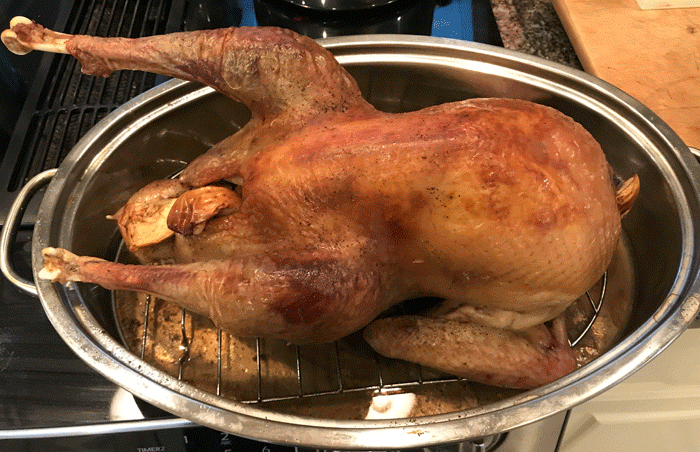
Do You Have Experience With Dental Materials? Please Share
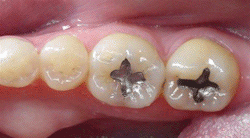
Question from Sharon
Hi Debra,
I just had a cavity fixed and I had a reaction to the dental bonding material – mouth got really extremely dry and burning sensation, hard to swallow, one part of my lower lip a little swollen -just from the fumes after she put the bonding agent in my tooth. It will be 3 days tomorrow since the work was done.
I have been using the same materials for several years with a little swallowing problems, but goes away after a day. I took just a little bit of antihistamine last night and woke up with a really dry mouth and sore throat. Very concerned. I see a holistic dentist but they just told me to gargle (??) I have done that a few times, flushed the mouth several times while I was there, brushed my teeth, gums, upper mouth, all over the tongue – still an issue.
Wondering if I might need to have this stuff removed. But not sure what I would put in place of it. I don’t want to go to urgent care, they will just tell me to take antihistamines. I did the dental testing. I am sensitive to everything.
Have you heard about any non-toxic glues/dental materials? Or, what do other people with MCS do or use? Thank you.
Debra’s Answer
Dear readers, I need your help answering this question.
I can research from online materials, however, the best answers come from real experience.
I am fortunate to have not needed cavities filled and other dental work, so I don’t have experience in this area.
But I know many of you have because you have given bits and pieces of information in other comments.
I’d love to put together a really good resource for getting nontoxic dental work done.
If you have knowledge or experience with this, please comment.
Thank you.
Heritage Foods USA
 Slow-growing, pasture-raised heritage breed meats are the most flavorful meats on the market. While they are not organic, they are real meat as nature intended and not hybrid breeds. Chicken, turkey, duck, goose, beef, pork, lamb, goat, plus bacon and charcuterie. “Heritage Foods USA was founded in 2001 to preserve endangered species of livestock from extinction. Endangered foods are saved when demand increases and farmers have the incentive to raise them. Slower growing pedigreed breeds are rare but chefs around the country swear by their superior taste. All our meats are raised on pasture by our network of family farmers and never fed antibiotics.”
Slow-growing, pasture-raised heritage breed meats are the most flavorful meats on the market. While they are not organic, they are real meat as nature intended and not hybrid breeds. Chicken, turkey, duck, goose, beef, pork, lamb, goat, plus bacon and charcuterie. “Heritage Foods USA was founded in 2001 to preserve endangered species of livestock from extinction. Endangered foods are saved when demand increases and farmers have the incentive to raise them. Slower growing pedigreed breeds are rare but chefs around the country swear by their superior taste. All our meats are raised on pasture by our network of family farmers and never fed antibiotics.”
Sewak Smile
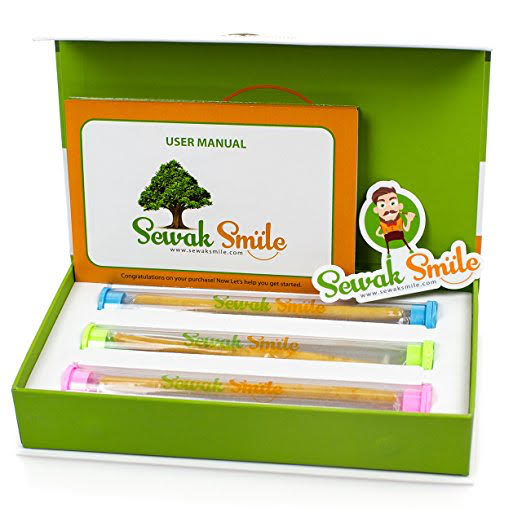 Natural “miswak” tooth-stick from the Peelu tree. Comes three to a box with color coded BPA-free carrying cases.
Natural “miswak” tooth-stick from the Peelu tree. Comes three to a box with color coded BPA-free carrying cases.
Linen Woman | Flax
 Linen clothing for women, sizes petite to plus. I found the FLAX brand of linen clothing in a local shop and fell in love with it, but they didn’t have my size. So I went online and found this site that is the #1 online shop for FLAX clothing. Lots of loose-fitting and tailored styles and colors. Simple. Classic. All are made with linen, some are combined with other natural fiber fabrics. And the prices online are much less.
Linen clothing for women, sizes petite to plus. I found the FLAX brand of linen clothing in a local shop and fell in love with it, but they didn’t have my size. So I went online and found this site that is the #1 online shop for FLAX clothing. Lots of loose-fitting and tailored styles and colors. Simple. Classic. All are made with linen, some are combined with other natural fiber fabrics. And the prices online are much less.






